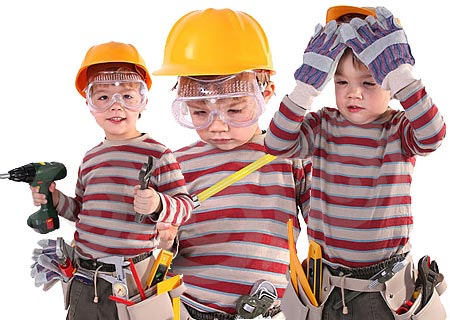Teach children about power tool safety
Teaching power tool safety to children is essential for preventing accidents. Even if your son or daughter shows no interest in heavy-duty woodworking, metalworking, or construction, they will still need to learn how to protect themselves while other people are using power tools.
Use the five steps below, and you and your child will both share a fine memory.
dreamstime
The first step in teaching power tool safety to children is to practice what you preach
If you say wearing eye protection is important but you don’t wear safety goggles yourself, you are sending a powerful- and dangerous-message to your child. Both of you should put on your eye protection, ear protection, and closed-toe shoes. Both of you should roll up your sleeves, keep clothing tight to your bodies, and tie back long hair. Lead by example, and follow the rules you set for your child.
Your second goal should be to make sure power tools are age appropriate
The best method is to start teaching safety through hand tools, such as a small handsaw, and then work your way up to more complex power tools once your son or daughter feels comfortable. Let your child attend a
DIY-Kids workshop. These workshops are designed to slowly introduce children to safely using the various power tools by teaching them the proper safety rules and procedures.
Third, clear the workshop and focus your child’s attention
Make sure that you both have enough room to work without tripping on cords, knocking down tools, or bumping into each other. Clear an adequate amount of space, and then double-check that there are no remaining distractions or interruptions. Your little student should not be distracted by dogs barking, siblings fighting, phone calls, iPod music, or anything else that could suddenly grab his attention and risk cuts, bruises, or worse.
Now you are ready to teach the basics of power tool safety
Show how tools should be held when they are in use, carried or put down when they are not, and turned off and stored when the job is done. Let children pick up the tools-powered off and unplugged-and investigate them before the initial trial. Just like with scissors, explain why running with power tools is not a good idea. Demonstrate how to control each power tool and possibly what can happen when the tool gets out of control-without hurting yourself! Remember that children’s hands are smaller, so they may need the help of a vise or clamps to stabilize materials while they hold the power tool with both hands.
Finally, start the session slowly and begin with low-powered, 'safer' tools. Be ready to help your child and take over if necessary. To make this first experience more fun, you may want to take your son or daughter to a kids’ power tool class offered by one of the major home improvement chains. Working alongside other children may minimize your child’s fears and your own. Even after teaching power tool safety to children, always supervise their actions. Make the introduction both safe and fun, and you will certainly work together on many more projects.

